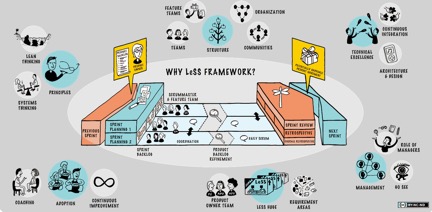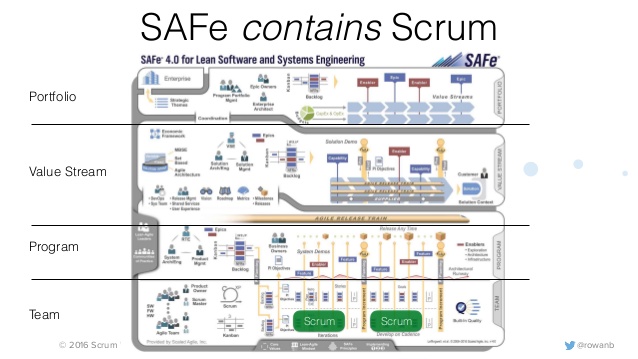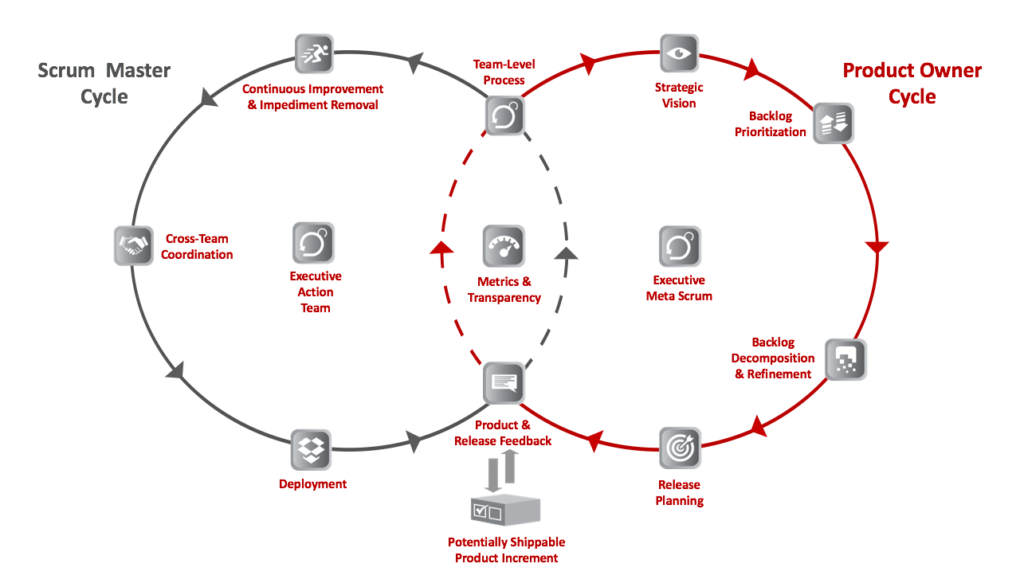There are about 10 different frameworks which may help firms scale with Scrum-Agile. The 3 most popular are: Less (Large Scale Scrum), SAFe (Scrum at Scale Framework), and S@S (Jeff Sutherland’s Scrum at Scale). The idea is to take the concepts and benefits of one Agile-Scrum team working on one defined project or product; and implement that model, across a domain or enterprise. Needless to say there are some issues with Agile-Scrum at scale as detailed here. However, over time, based on an Agile Centre of Excellence and C-level support, it may be possible to scale Agile-Scrum across teams. The following is a quick comparison of the 3 most popular Agile-Scrum frameworks:
Less
Less is a bottoms-up team based approach to scaling Scrum. It remains faithful to the original concepts of only having a Product Owner, Scrum Master and Delivery team within the Agile-Scrum process. The key addition is that the team interacts directly with the client(s). The PO is only a liaison with the clients and can therefore scale his role to be a PO for up to 8 Agile teams. This entails a new form of organisation which many firms will find difficult to implement.
Less Org:

Less Model:
SAFe
SAFe is the most popular framework for Enterprise Scrumming. A quick 5 minute video overview is here. It is based in part on ‘devops’ (a concept that has many definitions) and LEAN. It is a heavy, top-down approach to Agile-Scrum – with many layers of processes and checks. If you are a VLE with many layers and bureaucracy, SAFe is likely a better cultural fit. It is heavy and far more complicated and harder to implement than Less or S@S, advocating active management and an almost Waterfall approach to Scrum team builds and coordination. Concepts such as increments, cadence and releases are central to this active Agile management. Needless to say, there is an entire education-certification industry around SAFe and it appears to be as much a commercial venture as anything else. An overview of the organisation of SAFe is in a PDF here.
SAFe Model:
S@S
Scrum at Scale is an extension of the core Scrum Framework. S@S advocates a modular approach to scaling Scrum, the goals of which is to align the entire organization on a shared route forward through the use of a Meta Scrum.
The core argument for S@S is every Scrum-Agile project is different. Therefore the framework needs to allow for flexibility, adapting to each use case as needed. This modular approach should help developers to use modules as they are needed. It is not a hybrid framework as SAFe proposes. It is far closer to Less in maintaining the original intent of Scrum-Agile and putting development locus and power, back to development teams and SMEs.
S@S model:
Whichever model one chooses to follow, if you want to scale Scrum within the Enterprise, a key insight and necessity is to use Domain Driven Models and ensure that the Domain specific business logic is the foundation of system development and conforms to business requirements. You do this by embedding Domain experts into the Agile team.
==END


